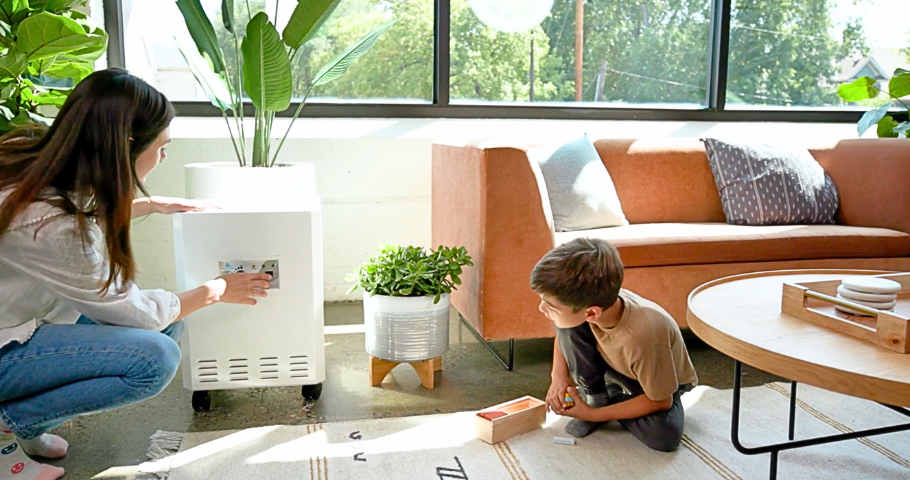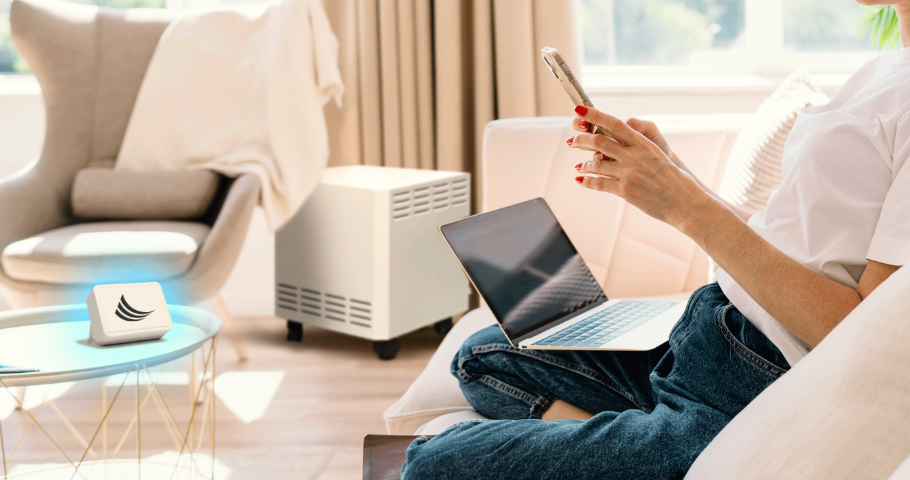Pollen Season Allergy Air Tips You Should Take: What the AQI Won’t Tell You
Every spring and fall, millions of people brace themselves for itchy, watery eyes, congestion, and a nonstop runny nose. And while many turn to the AQI (Air Quality Index) to gauge outdoor conditions, it turns out the AQI leaves a lot out in terms of allergy air tips — especially when it comes to pollen levels and seasonal allergies.

In this guide, we’ll break down why the AQI isn’t your full defense tool during allergy season, how indoor air irritants like dust mites, VOCs, and pollen infiltrate your space — especially during seasonal allergies — and share actionable allergy air tips to help you survive. We’ll also cover how tools like smart monitors, HEPA filters, and the right vacuum cleaner can help you breathe easier and support your immune system.
What the AQI Covers — and What It Doesn’t for Allergy Air Tips
The Air Quality Index (AQI) is a public health tool that tracks outdoor pollutants like ground-level ozone, PM2.5, and carbon monoxide. It’s helpful for smog or wildfire smoke alerts — but here’s the catch: the AQI does not include pollen levels.
That means even on a “Good” air quality day, pollen count could be sky-high, triggering allergic reactions like sneezing, sinus pressure, and even hay fever symptoms.
Even worse, the AQI doesn’t account for common indoor irritants like dust mites, pet dander, or chemical off-gassing from cleaning supplies and furniture, also known as VOCs (volatile organic compounds) — all of which the CDC notes as major contributors to poor indoor air quality.

Why You Still Suffer on “Good AQI” Days
Ever checked your app and seen a green AQI score, but still felt miserable? You’re not alone.
Pollen levels can soar during calm, dry, or windy days — when the AQI often reads as safe. Add in trapped indoor allergens during seasonal allergies to the mix, and you’ve got a perfect storm for allergic misery. Even low levels of tree pollen during early spring can lead to significant reactions in allergy-prone individuals.
Factors that make things worse indoors include:
- High pollen count sneaking in through open doors/windows
- Build-up of dust mites in bedding, carpets, and curtains can overstimulate your immune system, making mild allergens feel like major threats
- VOCs from candles, cleaners, or synthetic materials
- Poor ventilation that keeps airborne allergens trapped and suspended inside
How Seasonal Allergies Work Against You
Unlike one-time irritants, seasonal allergies are driven by recurring exposures to environmental triggers like pollen, dust mites, and mold spores. When these allergens enter your body, your immune system kicks into overdrive, releasing histamines that cause symptoms like sneezing, congestion, and itchy eyes.
Over time, repeated exposure can weaken your body’s tolerance and cause the immune system to react more aggressively — even when pollen levels or indoor irritants are relatively low.
Some of the most common culprits include tree pollen, grass pollen, and mold spores, all of which can overwhelm your system when levels are high.
Real Allergy Air Tips to Survive Allergy Season
To protect yourself during allergy season, you need to go beyond AQI apps. These expert-backed allergy air tips will help you build a safer indoor environment.
1. Track Pollen Levels Daily
Unlike AQI, you’ll need a pollen forecast tool to stay informed about pollen levels in your area. Try Pollen.com, WeatherBug’s allergy tracker, or review the Asthma and Allergy Foundation of America’s pollen guide for a deeper look at regional pollen patterns.. Many smart indoor monitors also include outdoor pollen forecasting features.
Set up alerts for when tree pollen or grass pollen counts spike, so you know when to keep windows closed, especially during tree allergy season, which typically peaks in early spring. Prepare any nasal sprays or medications you rely on during peak allergy days, especially if you’re sensitive to seasonal allergies. These simple steps can make a big difference for allergy sufferers trying to reduce daily exposure.
Consider setting up a free dashboard with SMARTView AQI, where you can access local pollen counts, forecasts, and more on the daily, plus scheduled reminders and alerts based on what matters most to you during pollen season.
2. Invest in a HEPA Filter Air Purifier
During allergy season, high-efficiency filters like HEPA filters and HEPA air purifiers are non-negotiable for capturing airborne allergens before they trigger symptoms. These filters capture up to 99.97% of microscopic airborne particles — including pollen, pet dander, and even dust mites — as confirmed by the EPA’s HEPA filter guidelines.
For full protection, choose a purifier that also includes an activated carbon layer to neutralize VOCs. Running it continuously in bedrooms and living areas can significantly reduce symptom flare-ups tied to seasonal allergies.

3. Vacuum and Clean with Allergies in Mind
Vacuuming is essential, but the type of vacuum cleaner you use matters just as much when trying to reduce airborne allergens in your home. Look for one with a built-in HEPA filter that traps dust mites, pollen, and pet dander instead of pushing them back into the air.
Here’s how to optimize your cleaning routine:
- Use your vacuum cleaner at least twice a week
- Wash bedding weekly in hot water to kill dust mites and remove mold spores that may cling to fabric surfaces.
- Use fragrance-free, low-VOC cleaners
- Clean air vents and change HVAC filters regularly to reduce buildup that can trigger seasonal allergies
4. Close Windows and Seal Entry Points
On high pollen level days, resist the urge to open the windows. Instead:
- Use weather stripping and door sweeps
- Keep pets groomed and off furniture (they track pollen in)
- Change clothes and shower after being outside
- Run your air purifier on high for 30 minutes after returning indoors
5. Use a Smart Air Quality Monitor
A smart monitor does what the AQI app can’t — it shows you what’s happening inside your home. Look for monitors that detect:
- PM2.5 and PM10
- VOCs
- CO₂ and humidity
- Indoor pollen levels (some models include this via connected data)
Smart monitors can alert you when to run your purifier, adjust ventilation, or avoid certain activities like cooking or cleaning with strong chemicals.

Common Myths That Keep Allergy Sufferers Miserable
Many misconceptions about seasonal allergies and indoor air can prevent people from finding real relief.
While allergy shots and medications can help manage symptoms, they don’t address the constant exposure to irritants in your environment, especially indoors.
- Myth: “AQI is all I need.”
➤ False. You need to track pollen levels, too.
- Myth: “I’m safe indoors.”
➤ Not necessarily. Dust mites, VOCs, and trapped pollen can make indoor air worse than outside.
- Myth: “I just need to vacuum more.”
➤ Only if you’re using a HEPA-equipped vacuum cleaner. Otherwise, you might just be stirring up allergens.
Your Allergy-Season Action Plan
- Check pollen count and pollen levels daily
- Use a HEPA + activated carbon air purifier
- Vacuum and dust with allergy-safe tools
- Wash linens and use allergen-proof bedding
- Use a smart monitor to track indoor air
- Replace HVAC filters monthly
- Keep windows shut on high pollen level days
- Keep nasal sprays and allergy medications on hand
- Keep eye drops on hand to relieve itching and watery eyes caused by allergens
Reclaim Your Air, Reclaim Your Comfort
The truth is, the AQI is just one tool, not the full picture. During allergy season, it’s what the AQI doesn’t show you that’s most important: pollen levels, indoor pollutants, and allergens like dust mites, airborne allergens, and VOCs that can turn your home into an invisible minefield.
With these practical allergy air tips and seasonal allergies in mind, pairing clean air strategies with any allergy medications your doctor recommends can help you finally take control of your environment — and breathe easier through seasonal allergies and beyond.
